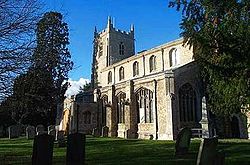Brampton, Huntingdonshire
| Brampton | |
| Huntingdonshire | |
|---|---|
 St Mary's, Brampton | |
| Location | |
| Grid reference: | TL205705 |
| Location: | 52°19’10"N, 0°14’1"W |
| Data | |
| Post town: | Huntingdon |
| Postcode: | PE28 |
| Dialling code: | 01480 |
| Local Government | |
| Council: | Huntingdonshire |
| Parliamentary constituency: |
Huntingdon |
Brampton is a village in Huntingdonshire. It stands on the River Great Ouse near Godmanchester south west of Huntingdon.
Brampton is most famously associated with Samuel Pepys, the Chief Secretary to the Admiralty and diarist whose house, Brampton House, still stands outside the village on the road to Huntingdon.[1] A local legend has it that his fortune is buried somewhere in the village [2] Brampton House was home to Robert Pepys, Samuel's brother, and later inherited by Samuel Papeys and used by him as an occasional home. Pepys was known also to have stayed at the Black Bull Inn in the village.
RAF Brampton lies on the edge of the village, an important employer for the village.
The great meadow of Port Holme lies within the Parish of Brampton.
Parish church
The Church of St Mary Magdalene or St Mary the Virgin (as it was once called), consists of a chancel with a north vestry, nave, north aisle, south aisle, west tower and north and south porches. This church is mentioned in the Domesday survey of 1086, but, with the exception of a few parts dating from the 12th century, no part of the current structure is earlier than the 14th century.
History
Brampton is mentioned in the Domesday Book of 1086, which records that there was a church and priest at Brampton in 1086. Brampton’s name has been variously recorded as: Brantune (11th century), Brantone, Bramptone (12th-13th century), Brauntone, Brampton (13th century)
At one time the higher part of Brampton parish was forest but now fewer than 300 acres of woodland remain. Brampton is generally low-lying, mostly being about 33 feet above sea-level, although the ground rises towards the south west boundary where it reaches a dizzying 164 feet.
The pre-history of the parish may be more grizzly. Scattered Human remains dating back perhaps 1,600–2,000 years have been found in one or more gardens of houses near the local primary school. The exact origin has yet to be determined.